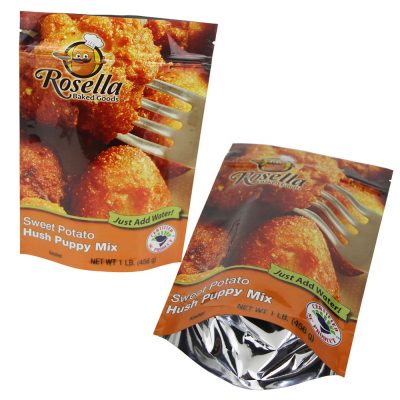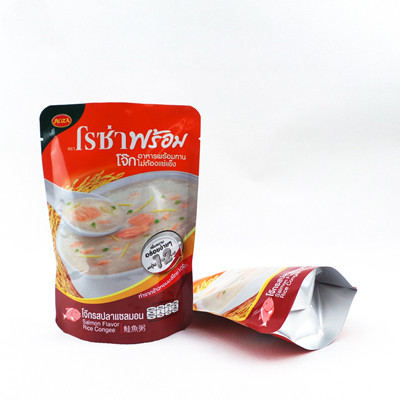In the process of meat production and processing, there are always two cooking processes, namely high temperature and high pressure sterilization and low temperature and normal pressure sterilization. The low-temperature sterilized meat products have a fresh and tender taste due to the low heating temperature and the fiber of the meat is not destroyed. Various nutrients are well preserved; but because it only kills the pathogenic bacteria, there are still a large number of spoilage bacteria, which not only has a short shelf life, And it is very easy to cause loss in the circulation field. High-temperature sterilized meat products have excessive shrinkage of meat fibers due to the high heating temperature, and the taste is not as good as low-temperature sterilized products, but because it kills all bacteria and eliminates the internal causes of spoilage, it can greatly extend the shelf life.
High-temperature sterilized meat products using high-barrier packaging materials will not only have a longer shelf life at room temperature, but also have convenient transportation, storage, and sales, which is very suitable for the consumer needs of modern society. Therefore, vigorously developing the production of storage-resistant meat products at room temperature is an important product development direction for the meat industry. The packaging industry conforms to this development trend, does something and innovates, which can not only meet the needs of the food industry, but also win a broad market for itself.
It is understood that the earliest packaging that can store meat at room temperature is canned food, which is an iron can made of tinplate, and later a glass bottle is used as the outer packaging. Both tinplate and glass bottles have high temperature cooking resistance and high barrier properties, so the shelf life of canned food can reach more than 2 years. However, because tinplate cans and glass bottles are rigid packaging containers with large volume and heavy weight, the chemical resistance of tinplate is not good, especially when it is loaded into acidic foods, metal ions are easy to precipitate, which affects the flavor of the food.
In the 1960s, the United States invented the aluminum-plastic composite film in order to solve the packaging of aerospace food. It is used to package meat food. It can be stored at room temperature through high temperature and high pressure sterilization, with a shelf life of more than one year. The function of the aluminum-plastic composite film is similar to the canned food box, soft and light, hence the name soft canned food. At present, when storing meat products with a long shelf life at room temperature, if rigid packaging containers are used, tinplate cans and glass bottles are still used; if flexible packaging is used, aluminum-plastic composite films are almost all used.
The aluminum-plastic composite film is a laminated composite multilayer film, generally three layers, and the typical structure is surface layer/adhesive/aluminum foil/adhesive/heat seal layer (CPP). The packaging film has the advantages of beautiful appearance and good mechanical properties, high barrier properties, high temperature cooking performance, excellent hygiene, light weight and softness, so it is widely used in various food packaging. But there are also some defects, such as the texture of aluminum foil is hard and brittle, and the flexibility is not good compared with plastic film.
In order to extend the shelf life of meat products, high-temperature cooking meat products are packaged in a vacuum-fitted body. When the aluminum foil composite material is vacuumed, due to the insufficient flexibility of the aluminum foil, it is difficult to completely stick to the contents, and it is easy to cause the air in the packaging bag to be unclean, which affects the preservation of the food. Therefore, the thickness should not be too high when using aluminum foil for meat packaging. But because its barrier property depends on the thickness and processing level, a large number of pinholes are prone to appear when the thickness is small. Therefore, the thickness of aluminum foil should not be too thin for the packaging of storage-resistant meat products; if the aluminum foil is too thin, the aluminum foil After the composite film is evacuated, many wrinkles will be formed, which will easily produce cracks and cause the loss of barrier properties. Therefore, the thickness, barrier properties, and flexibility of aluminum foil are always the three contradictions that plague the application of aluminum foil composite films.
From the market perspective, the opacity of aluminum foil composite film makes consumers unable to see the color and shape of the contents, which is not conducive to consumers’ purchase. In addition, some manufacturers use the opacity of aluminum-plastic composite film to conceal product defects, or even falsify , Entrap consumers. Therefore, most consumers choose completely transparent packaging instead of opaque aluminum-plastic composite film packaging, resulting in poor sales of such packaged foods. Aluminum-plastic composite packaging cannot be heated by microwave, and it is more expensive than plastic film, which affects the application of aluminum-plastic composite film. Therefore, the food processing industry has always hoped that the packaging material technology can provide a packaging material that is similar to the aluminum-plastic composite film in barrier properties, but is completely transparent and can withstand high-temperature cooking instead of the aluminum-plastic composite film.
Among the plastics currently used in industrial applications, only PVDC plastic film has both high barrier properties similar to aluminum foil and high temperature cooking resistance. For a long time, people have hoped to use PVDC plastic as the intermediate layer to make a composite film to become a fully transparent, high-temperature cooking-resistant, and high-barrier-resistant high-temperature cooking food packaging film similar to aluminum foil. However, PVDC plastic is a kind of plastic with unique properties and extremely difficult to process. There are many difficulties in using it as an intermediate layer to manufacture composite films.
PVDC plastic film is manufactured by a special blown film process invented by scientists from Dow Chemical Company in 1938. Since the 1950s, it has been used as the casing of high-temperature steamed meat enema. The high-temperature sterilized meat products packaged with it are stored at room temperature and have a shelf life of more than 6 months. However, the PVDC film can only be heat-sealed by high-frequency dielectric heating, and cannot be heat-sealed by the commonly used resistance heating method. Therefore, for many years, the PVDC film has only been used as a casing and cannot be used as a packaging bag.
In recent years, experimental studies have shown that the solvent-free compounding method can directly compound the PVDC film into a composite film without any treatment. This kind of composite film will not be damaged in the shape of the whole film during high-temperature cooking, and it will always remain flat and smooth, tightly combined, and mixed into one body, which can fully meet the needs of high-temperature cooking food packaging. After the PVDC laminated composite high temperature cooking food packaging film made by this method was put on the market, it was affirmed by experts and proved that it has the three characteristics of high transparency, high barrier and high temperature cooking resistance after the aluminum-plastic composite film. The performance index of food packaging film has reached the international advanced level.
Compared with the aluminum-plastic composite film, the PVDC laminated composite film has similar barrier properties, is completely transparent and softer. It is used for the vacuum skin packaging of meat food. The air in the bag is very clean, which is more conducive to the preservation of meat food and can be microwaved. Heating, and the price is only equivalent to 70% to 80% of the aluminum foil composite film, so it can replace the aluminum-plastic composite film application in a considerable range.
At present, the research and development of polyvinyl alcohol (PVA)-based BOPP-coated barrier films has brought new hope to food packaging. This kind of barrier film has both oxygen barrier properties and water vapor barrier properties. The polymer does not contain toxic elements, and the transfer of toxic elements will not occur during use. The barrier material PVA is a microbial synthetic polymer material, which has hydrolysis and biological properties. The dual degradation mechanism of degradation can completely degrade into water and carbon dioxide. It is a high-performance environmentally friendly material that can replace PVDC coated films in many aspects. It is mainly used for the packaging of meat foods, quick-frozen convenience foods and non-food flavor-preserving types (such as insect repellents), and has broad application prospects.




















